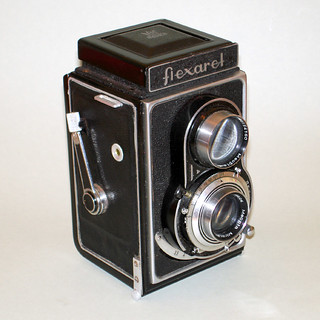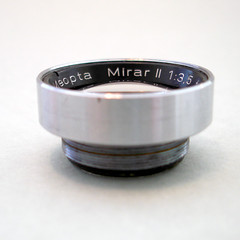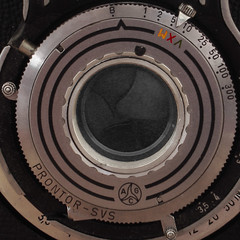Flexaret III

|
| image by Dries van den Elzen (Image rights) |
Contents
Introduction
The Flexaret series of TLR cameras was made by Meopta (and its predecessors) in Czechoslovakia. The Flexaret III is the only Flexaret to have an advance crank, not a knob.[1] It is a fully mechanical camera with an all-metal body. The body is covered in black leather. The Meopta logo is on the black sports finder of the viewing hood. The name plate is marked flexaret only.
Transport and shutter
The film is advanced by a lever that springs back after transport. There's no automatic stop; check the ruby window in the back for the next frame number to appear. The tip of the lever folds for compact transport, like on the Minolta Autocord. The Flexaret III has a Compur rapid shutter (B, 1–1/500s). On model IIIa, the shutter is a synchronized Prontor-S (B, T, 1–1/300s). The shutter speed ring is around the taking lens. Transport does not set the shutter, it must be set with a small, red-tipped lever on the right side of the lens.
The crank-winding on the III and IIIa was an attempt of Meopta to match the Rolleiflex TLR's but due lack of knowledge they failed to make it reliable and meopta returned to the knob system (like the Rolleicord) when they released the flexaret IV. It's wise to find out if the crank mechanism still works when you purchase a Flexaret III(a) because repairs might be impossible.
Lens and focus
The taking lens is a Mirar 80/3.5, made by Meopta itself. The viewing lens is an Anastigmat 80/3.0. Focusing is done by an anchor on the bottom of the taking lens, just like on the Minolta Autocord I. The lens can be stopped down to f/22. The stopping down is stepless and controlled by a lever under the lens. Meopta made push-on filters for the Flexaret II, III, IV and V. They have a 30mm diameter. On the Flexaret VII and VI, an internal and external bayonet (B36) was used. This means filters produced for the earlier Flexaret models can not be used on the later models.
Variations
The Flexaret III has an unsynchronized Compur shutter and the Flexaret IIIa has a synchronized Prontor-S shutter. Some Flexaret IIIs have a Metax shutter (1–1/400s).
- Flexaret III (1948)
- Flexaret IIIa (1951–1956)
Export model

|
A special variation of the synchronised Flexaret IIIa was made for the american market,[2][3] the Flexaret IIIa Crown. The distance scale is in feet only and the Meopta logo on the hood is crowned. The shutters are either Prontor-S or Prontor-SVS. The fast speeds on the shutter ring of this export model are on the left, contrary to european model. Within this rather exotic category of Crown Flexarets, there seem to be at least two variations: One model with a Prontor-S shutter, a synchro-contact in the side of the camera, a flash scale under the taking lens and decorative concentric circles around the crank[4], and one with a Prontor-SVS shutter lacking the above features (pictured in this article).
Maintenance
Old TLRs often suffer from oily shutter blades impairing their use. Amazingly, the front elements of the Mirar II can just be screwed off, giving access to the shutter blades and allowing one to clean the lenses.

|
| image by Dries van den Elzen (Image rights) |

|
| image by Dries van den Elzen (Image rights) |
Links
- Flexaret III page showing the various models at Flexarety.cz (in Czech)
- Flexaret III at Sylvain Halgand's www.collection-appareils.fr (in French)
- Flexaret III instruction manual in PDF format (English) from OrphanCameras.com website.
Notes
- ↑ McKeown, James M. and Joan C. McKeown's Price Guide to Antique and Classic Cameras, 12th Edition, 2005-2006. USA, Centennial Photo Service, 2004. ISBN 0-931838-40-1 (hardcover). ISBN 0-931838-41-X (softcover). p662.
- ↑ Czech cameras: Flexaret, Optikotechna-Meopta by Václav Vait
- ↑ Advertised in the November, 1951 U.S. Camera at a price of USD $99.88.
- ↑ Czech cameras: Flexaret, Optikotechna-Meopta by Václav Vait